Welcome to a new issue of the Journal of Runic Studies, the premier Malkioni publication for studies into the nature of Glorantha. If you haven’t subscribed yet, please consult with the spirit bound to the appropriate electronic page.
God Learner Sorcery
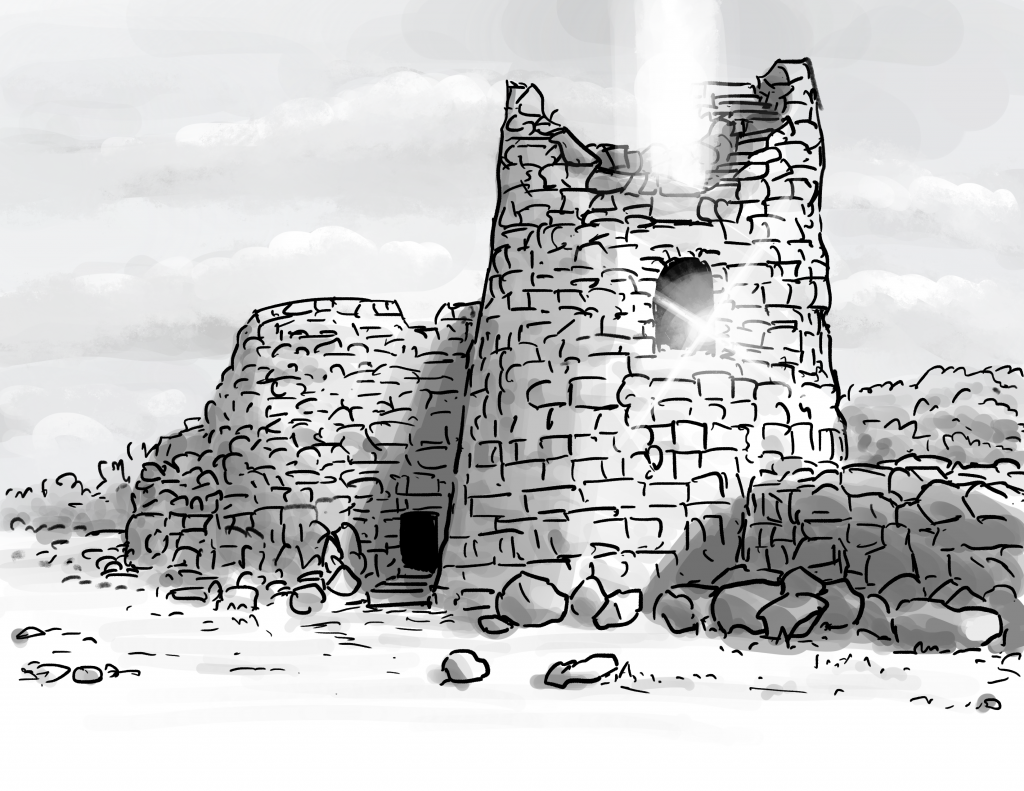
We are now occupying a nice little tower with a long history of previous occupants who have left behind documents, tablets, artifacts, and other kinds of junk. As we clean up and archive these things, we share the most interesting ones with you.
Writing Adventures in Glorantha
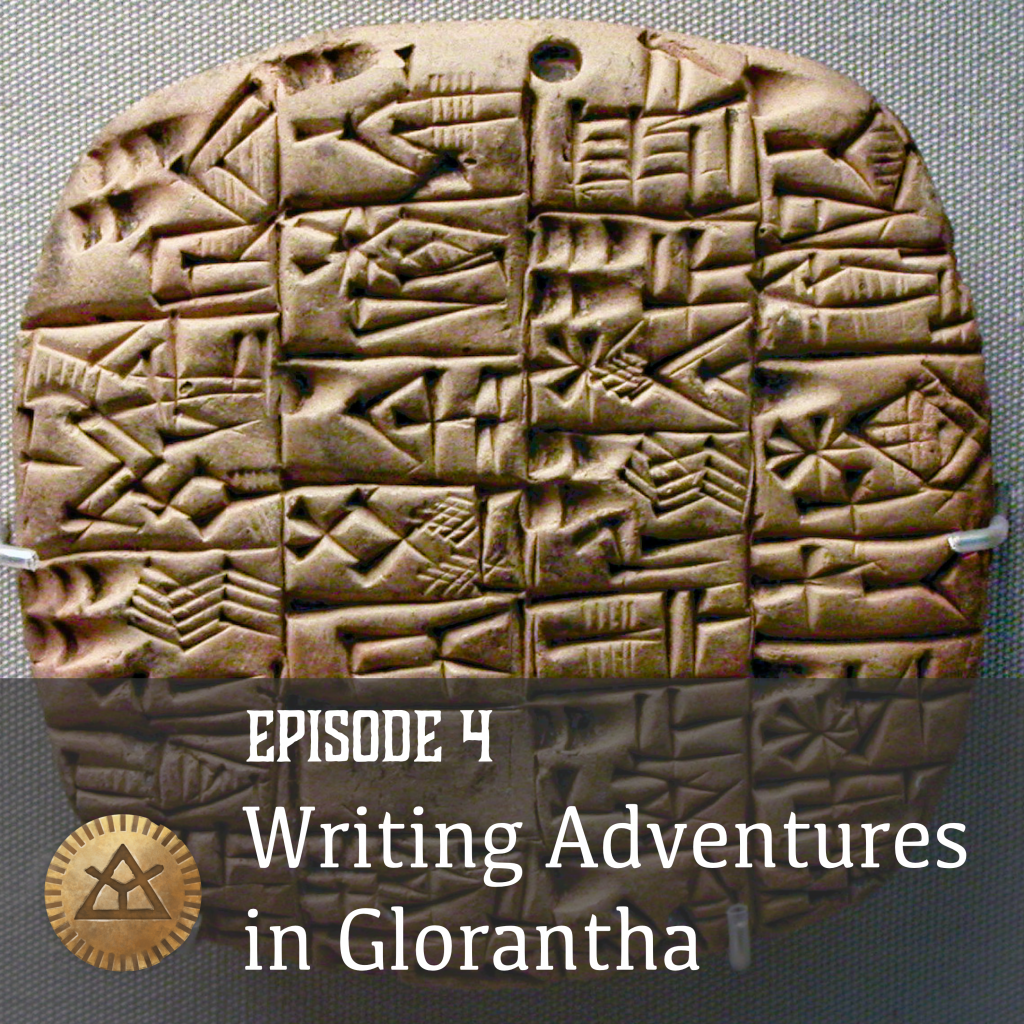
Episode 4 of the podcast is finally out! We talked to most of the crew from the Beer With Teeth collective, who have written many great adventures and sourcebooks for the Jonstown Compendium. Diana, Dom, and Erin share their creative process and other tips for writing scenarios for RuneQuest Glorantha, in an episode full of ramblings and generally applicable RPG authoring advice!
Chaosium News

Here are this week’s Chaosium news!
Beginner’s Guide to Glorantha
James Coquillat interviews Jeff Richard about introducing Gloranthan deities to new players. It’s a nice video that you can pillage for short descriptions of the main gods… it might come in handy if, left to your own devices, you tend to rant for too long about Glorantha because you’re so excited about it! (I’m looking at you, you, and you over there… yes, you know who you are!)
And while some gods are easy to describe and grasp in one sentence (Chalana Arroy or Issaries, for instance), others aren’t that obvious. Funnily enough, the first non-obvious god that James asks Jeff to describe is our good old pal Yelmalio. Jeff also clarifies the differences between the different warrior gods, and what you can do as an Ernalda cultist.
Jonstown Compendium

The Jonstown Compendium is Chaosium’s community content program for all Gloranthan games, hosted on DriveThruRPG. Disclaimer: all the relevant links are affiliate links that hopefully will let us cover some of the hosting and maintenance costs for the website and podcast! Thanks for using them!
Korolstead
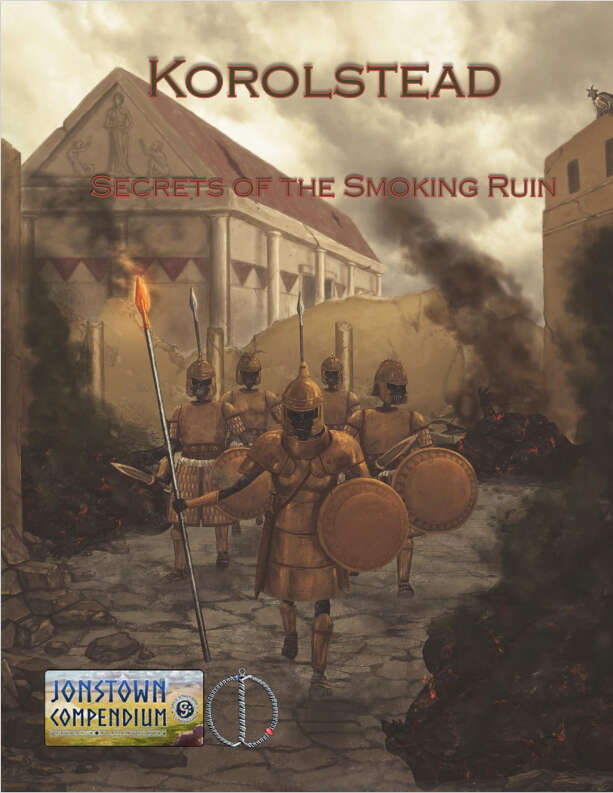
John Lawson gives us a companion to the Smoking Ruin & Other Stories with Korolstead: Secrets of the Smoking Ruin. This expands what can be done to the already hefty Smoking Ruin adventure by providing extra maps, scenario seeds, NPCs and factions, encounter tables, and much more.
A Bad Day at Duck Rock
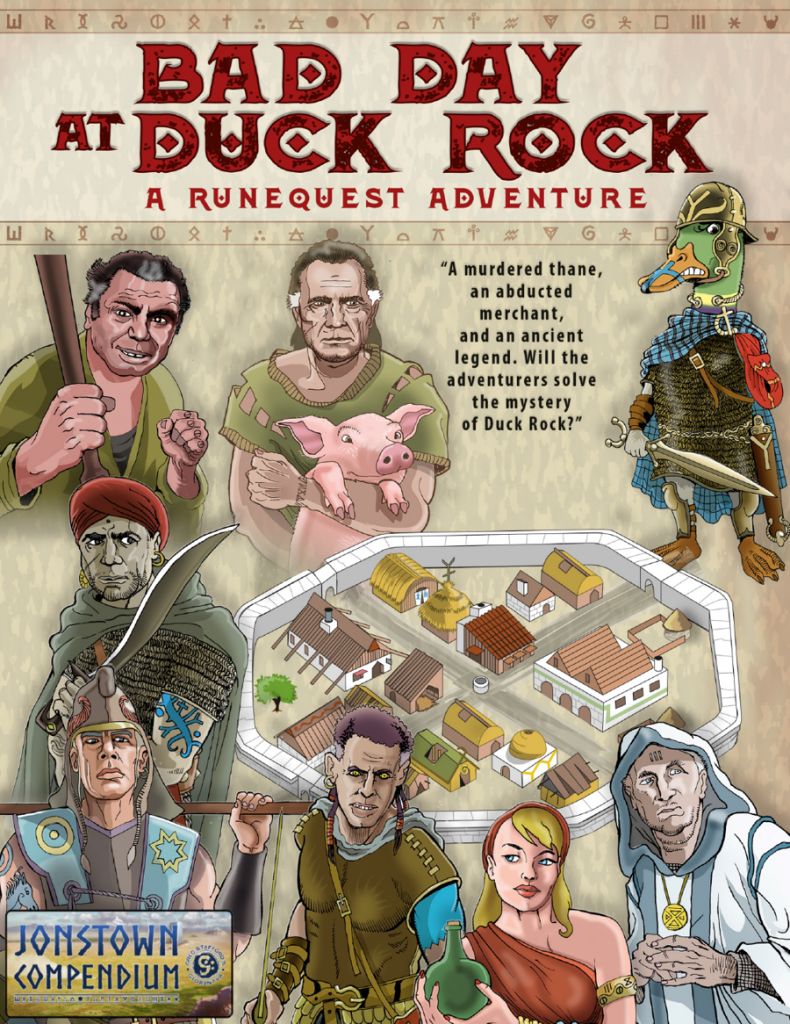
A Bad Day at Duck Rock by Peter Hart, illustrated by Dario Corallo, places the party as escorts to a merchant carrying various metals from Dwarf Run to Manville in Beast Valley through Duck Valley. An easy task given to the characters while the merchant takes a short side-trip, what could possibly go wrong? Find out in a duck-laden scenario.
Jeff’s Notes

Jeff Richard, the current mastermind on everything Gloranthan at Chaosium, is often posting notes and thoughts on the RuneQuest Facebook group. Here’s our curated list from the past week. A partial archive of these sources is compiled on the Well of Daliath.
Argrath and Alexander
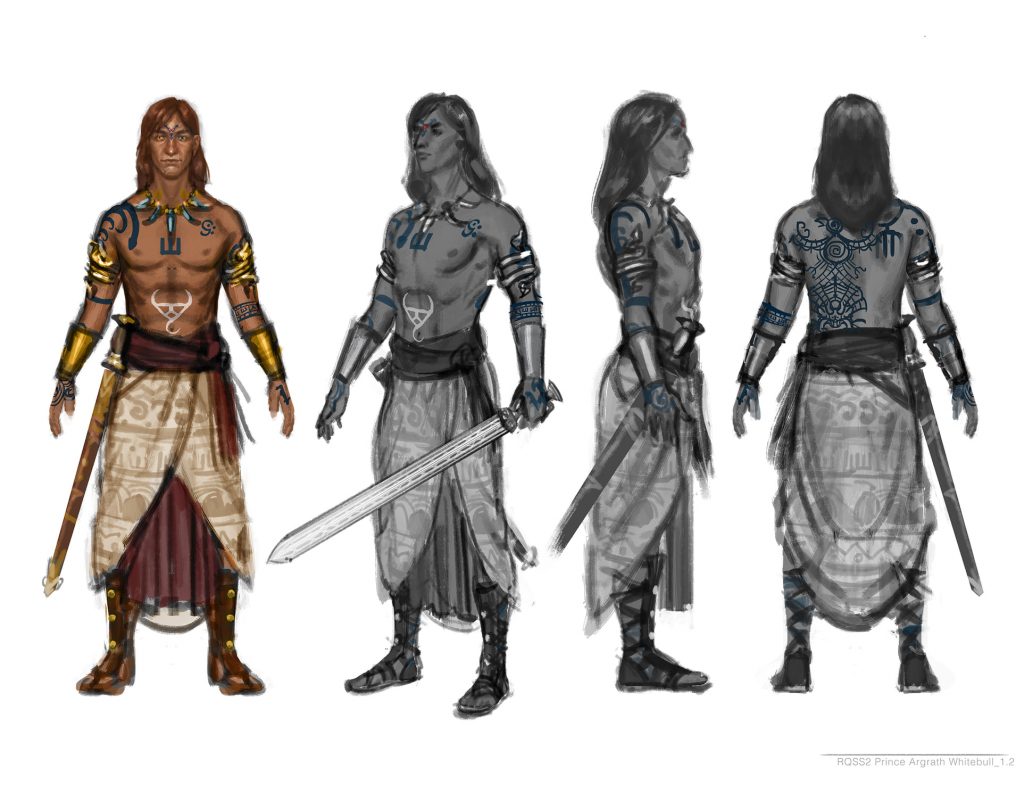
We’ve known for a while that Alexander “The Great” is a source of inspiration for the character of Argrath, but now Jeff gives us some proper comparison points:
Think of Classical Greece during the rise of Philip and Alexander. At first things aren’t too different from what they have been for the last century or so. We have our polis, and it is always the same major players – Thebes, Sparta, and Athens. And the Persian Empire is on the eastern shore and playing everyone off each other, a constant threat.
But within a generation, there is a Macedonian Empire, with generals who have made themselves kings, a a king who has made himself a god. And the polis are left making statues and obeisances to generals who rule armies, not lands.
And so something similar happens in Dragon Pass, i.e. a lot of change over a short period of time.
A snippet from the upcoming Sartar Homeland boxed set tells us about the many changes that Argrath enacted to his nation’s military. Before his arrival, Sartar’s armies were made of “inexperienced” tribal militia and “exhausted and semi-rebellious mercenaries” such as the various warbands that followed Kallyr for the past decade. But Argrath arrives with a competent cavalry that has years of combat experience together, and this changes things.
The reasons for this are several: 1. The existing warrior structure of Sartar had evolved to become rich, mounted noblemen (called “thanes”) leading armed mobs of freemen; 2. Dragon Pass, and especially the traditional friendship between the House of Sartar and the Grazelanders, was rich in horses; 3. Argrath’s own life and training was among the animal-riding nomads of Prax (except for the three years he spent as a Wolf Pirate) and he made brilliant use of the cavalry at his disposal (however, Argrath’s generalship always made excellent use of the forces he had at hand, even second rate infantry); 4. The magical powers which Argrath summoned to his aid were closely bound with wild rampages and shock tactics.
Argrath began assembling his army soon after he was driven from his home on Starfire Ridge when he took refuge among the nomads of Prax. Most tribes there had strict laws and customs restricting any foreigner from holding a position of authority or power, but there were several secret societies whose membership crossed all social or political boundaries. Incredibly, Argrath worked his way to supremacy among three of them. These units, the Twin Spears, Sword-brothers, and Bullocks, formed the kernel of his Free Army. After he received the gift of the Dragon’s Teeth, Argrath returned to Dragon Pass.The native Sartar tribal militia and the first initial units of the Sartar Free Army and the Sartar Magical Union, reinforced by Praxian nomads and some Holy Country volunteers, carried the weight of the early fighting.
From there the Sartarites grew into a unified army, alongside allies like the Grazelanders and the Tarsh Exiles, and mercenaries like the Sun Dome Templars, Dragonewts, and so on.
Of note:
Sieges were usually left to specialists which were organized and led by the famous engineer, Haraspac, rumored to be of dwarf blood.
Argrath’s friendship with the dragonewts extended to wyrms and even dream dragons. Such draconic allies were increasingly common in his later campaigns.
Orlanthi Justice
Here’s a short note on Orlanthi views on society and justice:
The Orlanthi encourage independence over centralization. They do not have faith in a single leader for all things, a single god for all things, or for a single rule to cover all eventualities. They know that their own rules may not be the same as others, and that difference is not bad or evil, and sometimes even has great good.
Justice is the “right way” of the world. Orlanth is the lord of justice, and his changeable nature indicates that justice too must be suited to the circumstances of anything being judged. The Orlanthi believe a single rule is not possible. Justice to one’s family, clan, tribe, and nation means to follow the ways of Orlanth. Justice to outsiders is determined by their actions, but requires curiousity, tolerance, and honest restraint on the part of the Orlanthi until the stranger proves themselves a friend or enemy.
There’s some more interesting follow-up notes:
Those who imagine the Orlanthi as being die-hard traditionalists who resist change, resent cities, don’t engage in trade with strangers, or who think think they favour a single leader, single god, or single rule – I think you forget who Orlanth is.
This openness to change is a key theme in the Hero Wars, as the Orlanthi undergo tremendous social and even religious changes from 1625 to 1655.
Dara Happan Justice
To contrast with the previous note, Jeff talks about justice in the Lunar Heartlands under Dara Happan traditions. As one can expect, it’s a lot more strict:
1. Proper social order. That means everyone is in their proper place, with the strong restrained from harming the weak (any more than is proper, of course), with everyone doing what is proper for the social position for the good of the community. This proper social order is derived from the gods, in particular Yelm, and entrusted to the Red Emperor to establish, maintain, and defend.
This is all written down in rules and laws.
2. Vengeance against those who have wronged. The wheel of vengeance will eventually crush all those who have wronged others. One must suffer, that is part of existence, but in the end, justice requires that those who suffered unfairly must be avenged. This is derived most strongly from the Red Goddess, although there are clearly Carmanian and Spolite antecedents to this. This is usually entrusted to the Red Emperor and his family.
This explains why, for instance, the Red Emperor’s daughers like Hon-Eel and Jar-Eel are often sent out to kick some ass around the Empire, depending on the Emperor’s mood.
Of course, this is directly opposed to the Orlanthi:
Unlike the Orlanthi, the Dara Happan culture favors the idea of one ruler for everyone (the Red Emperor), one set of rules for everyone ideally, and at times even flirts with the idea of one supreme god (or goddess).
Apocalypse Now
While Argrath is Alexander, Jeff imagines Arkat, especially in the late Gbaji Wars, as Colonel Kurtz, from Apocalypse Now.
I could imagine him giving Harmast this speech shortly before entering Dorastor:
Unlike Colonel Kurtz, however, Arkat gets to retire on a farm “in Ralios, protected by his ferocious Zorak Zorani children, parceling out his wisdom and epigrams to any who will listen”.
Now this part gets interesting:
Unlike Hrestol, who slew his irrational unconsciousness and destroyed his shadow in order to bring forth the rule of reason and will, Arkat rationally embraced his unconscious and became his own shadow. In the end, Arkat fully embraced the Darkness in order to extinguish the Light of Nysalor.
One might […] view the Red Goddess as an attempt to create a synthesis of Nysalor AND Arkat. Of Nysalor AND Gbaji. Of the Full Moon and the Black Moon.
And perhaps Argrath creates a synthesis of the destroyer and the balancer.
Dendara’s Runes
The Guide to Glorantha continues to gather small “errors” as some details get revised in new material. Is there a Guide to Glorantha errata somewhere? I don’t think so?
Anyway, those with the upcoming RuneQuest Cults of Glorantha preview noticed that the Runes for Dendara have been changed, from the Guide’s Light and Harmony Runes, to, effectively, the same set or Runes as Ernalda (Fertility, Earth, Harmony). Jeff replied to this succinctly:
Yeah, well I have done a lot of thought about Dendara specifically since I wrote the Guide. She has the same runes as Ernalda. Indeed she is so similar to Ernalda that the God Learners were absolutely convinced that they are the same deity.
We at the God Learners are indeed convinced of that. Right Joerg?
Except when she isn’t. All that Dendara = Entekos = Sedenya stuff looming…
Dart Wars
Jeff writes a note about a little played aspect of Glorantha: the cloak and dagger conflicts between noble houses of the Lunar Empire known as the Dart Wars:
The combatants in these secret wars are spies and mercenaries, analogous to ninja, that are hired by the houses. The Red Emperor himself is rumored to actively participate in Dart Wars and is the likely the single biggest employer of Dart Warriors. It is rumored that there are entire clans of Dart Warriors, training in secret.
As a result of the Dart Wars, the noble houses absolutely do not trust each other and prevents them from allying against the Red Emperor.
The most obvious result of a Dart War is when a ruling family of a satrap is replaced by a new family; but Dart Wars often involve control of a powerful temple or rule of a city.
Among the four campaign ideas that sprung to my mind when I discovered Glorantha, one of them was definitely a spy action thriller set across the Lunar Empire… I’m still hoping to run it one day! But even if you play in good old Dragon Pass or Prax, you can include a bit of the Dart Wars in your game:
The background presence of Dart Wars can explain some of the erratic decisions of the Lunar Army in the Provinces and elsewhere. They keep the ruling families divided and make it easier for the Red Emperor to assert his authority, which is far more important than some barbarian province.
It also means that much of the actual administration of the Lunar Empire is not so much in the hands of the powerful noble families with their Red Goddess initiates and temples, and weird ambitions, but in the hands of Irrippi Ontor clerks who just keep their heads down and issue papers.
Dwarf Danger!
Here are Jeff’s suggestions for weird dwarven things to throw at your players:
Jolati with buggy pre-programmed commands.
Gobbler seeking stolen gunpowder.
Angry spirits escaped from a faulty Silver Dwarf energy matrix.
Mechanical construct (tiktok) with limited self-awareness.
Bound energy construct, abandoned by Silver Dwarfs.
My players already kind of know this, but Jeff also reminds us that “Dwarven mines and strongholds [are] full of weird things that the dwarfs used to assist them in their labor, sources of energy, or defensive systems”.
Strange Foods in the Holy Country
Here are some strange facts about the Holy Country:
The strangest livestock in the Holy Country has got to be the pig variant popularly called the “Sausage Loaf”. These are huge animals – weighing up to 500 kg but exceptionally calm, gentle, and even submissive – and are famed for their incredibly tasty meat.
And another:
A runner up for strangest food source is the giant sloth found in the forests of Heortland and Esrolia.
Community Roundup
The community roundup is our highlight of interesting things being mentioned in the Glorantha-related Facebook groups, sub-Reddits, and other similar online places.
Lace and Steel on RuneQuest
Author and game designer Paul Kidd (aka “Pauli”, aka “Lace & Steel”, aka “Mistress Lenalia of Duck Point, Rune Priestess of Humakt”) made a video about RuneQuest, its history, its supplements, Gloranthan humour, religion, and everything they like about the game. You can also catch Pauli’s funny quips about RuneQuest edition wars, or insightful short comments about melee combat mechanics compared to real life melee combat.
Of course, the video eventually gets to the latest RuneQuest Glorantha edition, with Pauli giving a review of it. This review goes into interesting opinions, given Pauli’s big background in 2nd edition RuneQuest — the big increase in how much the lore and setting are described rather than hinted at, or the loss of “charm and comedy”, for instance. Pauli does however make a point of stating how much RuneQuest was innovative and influential in terms of game design, and concludes with “wonderful to have it back” and a toast to Chaosium.
If you have a glass in your hand right now, you can join Pauli in the toast.
Teelo Imara Gives Proof Before The Court of Virtue
Eff’s highly recommended blog Eight Arms and a Mask offers a new entry from the Zero Wane when the Red Goddess still walked the earth. The Goddess of Virtue has a planet in the sky, and while she is worshiped as one entity in parts of Peloria, the Dara Happans recognize two deities associated with the House of Virtue, Entekos and Dendara. This story has the Red Goddess incarnate use an uncomfortable truth about the goddesses to prove her divinity.
The disclaimer framing the story dates this as a sixth wane Imperial College research document of dubious (read: heterodox) provenance, the stuff that new heresies are founded on. Putting such a disclaimer into a document accessible to students of experimental heroquesting is of course an ingenious way of getting this research done without having to apply for imperial funding…
Akhelas Updates
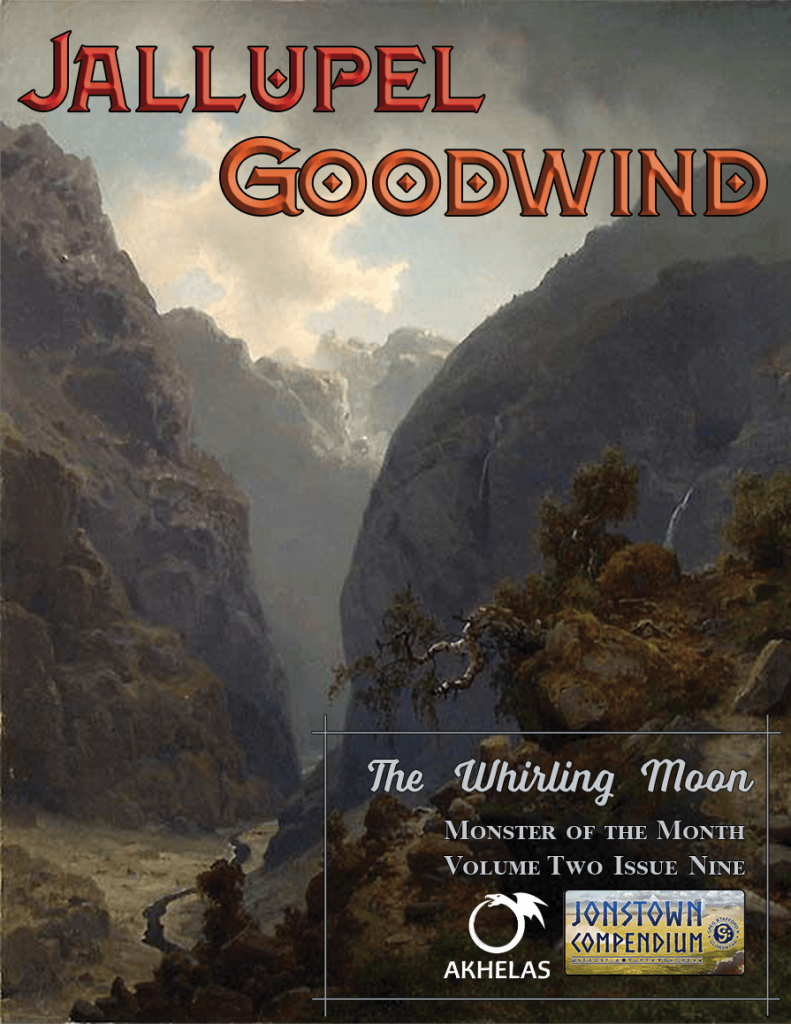
Austin Conrad has another blog article out following the latest Monster of the Month, Jallupel Goodwind, which was a collaboration with Beer With Teeth’s Diana Probst. It goes quickly over a few “behind the scenes” bits for that issue, and then updates us on Austin’s other projects. We have confirmation that MotM will, as planned, end with the current second series, and that it will include a “plus sized” issue, like last year’s Quacken. We also learn that writing on Volume Two of Treasures of Glorantha is underway!
Black Elf by CrimFlower

Over on Twitter, @CrimFlower made an illustration of their black elf character… we don’t see many Voralans in illustrations so it’s nice when one pops up!
Elsewhere on Arachne Solara’s Web
Not everything is about Glorantha, although most things are! Here are loosely relevant things that we found on the interwebs.
Using Myths for Science

In this article from the Smithsonian Magazine, scientists look at myths from Makin Island to help figure out how three huge out-of-place boulders ended up there. It’s also nice to think about it in reverse, too: how you can imagine what “really” happened, and make a myth out of it.
An Exploration of Ancient Pig Herding
This video offers an exploration into pig domestication in a region where pigs are now taboo, using archaeological data as well as the biblical research on Levithicus.
One interesting factoid brought up was that pigs roaming refuse-littered streets in crowded cities actually improve the sanitation by consuming all manner of refuse, including even nightsoil, and reducing the exposure to infectious material.
Thank you for reading
That’s it for this week! Please contact us with any feedback, question, or news item we’ve missed!


